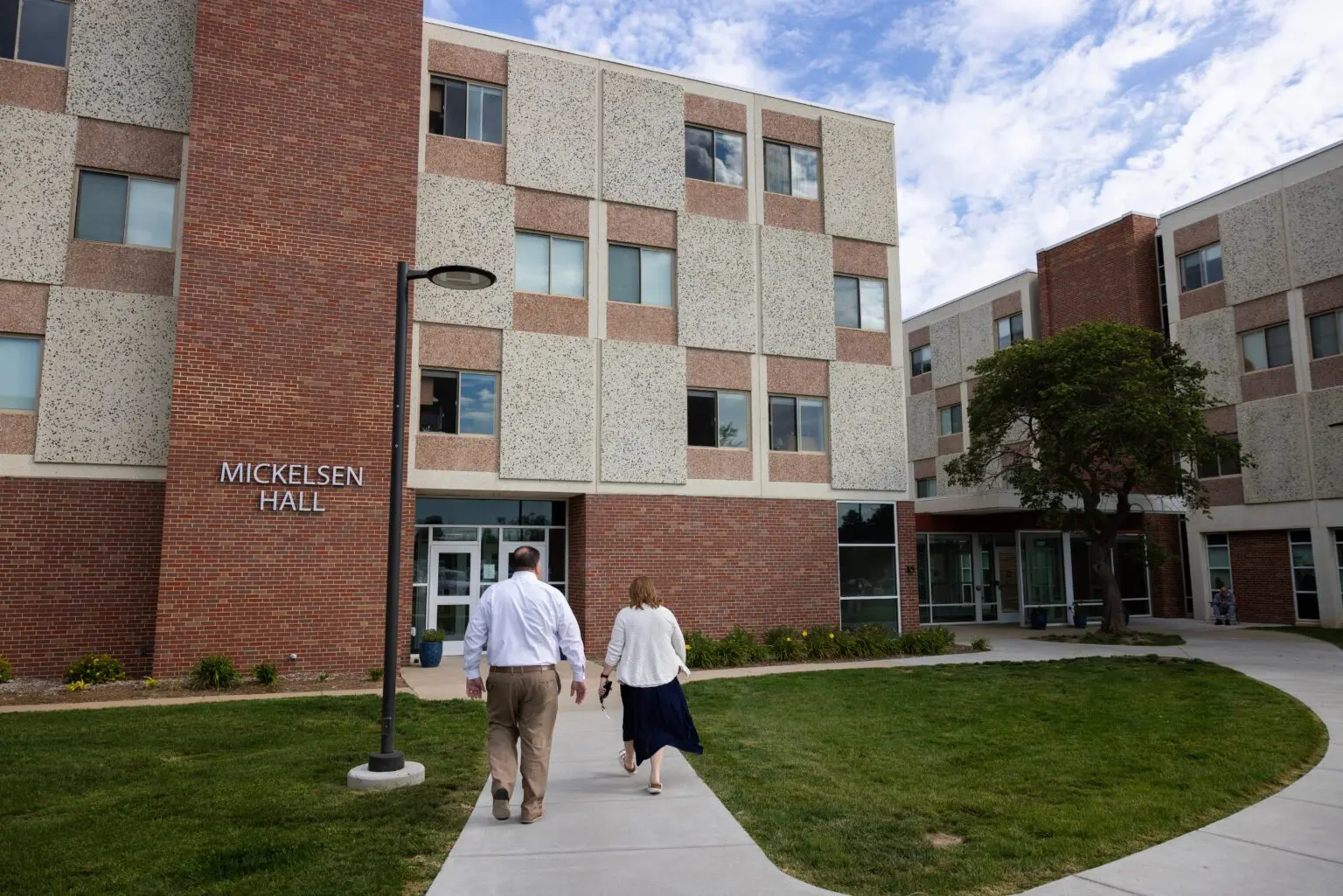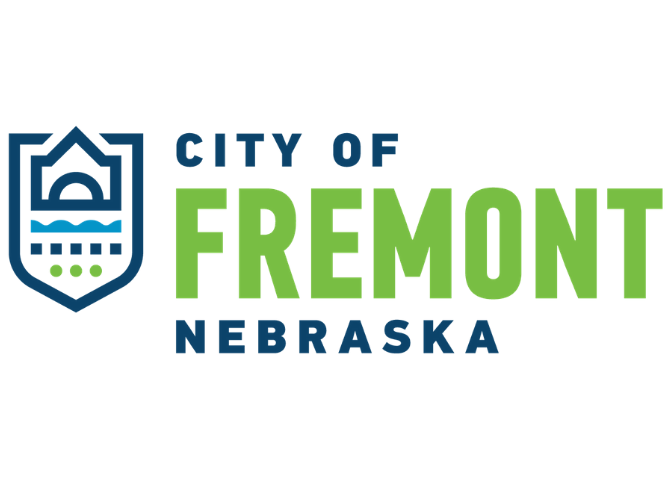
Chris Tonniges, left, CEO of Lutheran Family Services, and Stephanie Gardeman, director of the Root and Rise Program, walk into Mickelsen Hall on the former Dana College campus in Blair. (Rebecca S. Gratz for the Nebraska Examiner)
—
Erin Bamer
Nebraska Examiner
BLAIR — Tucked away on a hillside in Blair, the Dana College campus sat vacant for the better part of 15 years. But in recent years the property has gained new life through the work of a local nonprofit.
The private Lutheran-affiliated college closed abruptly in the summer of 2010, leaving the staff and roughly 600 students at the time in a lurch. After the land shuffled through several different owners, the property ended up in the hands of Lutheran Family Services, a nonprofit that offers family and health services.
The group has since repurposed two of the college’s aging dormitory buildings — Mickelsen and Blair Hall — into apartments, and some of the units are now occupied by young adults who have aged out of Nebraska’s foster care system. The campus grounds now have a new name: “Dana Village.”
Lutheran Family Services CEO Chris Tonniges said the nonprofit plans to renovate the remaining buildings for other uses over the next few years. Multiple Dana alumni said they are thrilled with the new direction their old campus has taken.
“We have faith now that our shining college on a hill is going to have a strong future,” said Sandra Jensen, who leads the Dana College Alumni & Friends Association.
Small colleges have been closing at an increasing pace throughout the U.S., which can prove detrimental both to the campus population and the communities they’re located in. But in Blair, while Dana College’s closure certainly made a dent, the city has survived.
Dana’s closure
Bob Coffey, president of the still-operating Dana College Foundation and who served on the college’s Board of Regents in 2010, said the regents knew the college was in financial trouble. Specifically, it was in debt to bondholders who intended to seize the campus if they weren’t paid.
Even so, Coffey said the board was hopeful about ways they could keep the college open. He said the group’s main avenue was to shift the college to a for-profit model, but when regents were denied by accreditors, they didn’t have enough money to remain open for another year. The college closed that summer.
The closure was “brutal” to the college’s community, Coffey said, as most were not expecting it, and there was no telling what would come next.
“There’s no blueprint to follow when a college closes,” he said. “People think they will be there forever.”
Many alumni also have strong emotional ties to the campus. Coffey was the second generation in his family to attend Dana College, and started his schooling there 55 years ago. He got tearful recalling the “family” environment that was forged there between the students and their professors.
“They weren’t there to do research,” Coffey said. “They were there to do teaching.”
Dana’s closure also had a major impact on Blair’s business community, as the student population contributed between 300-500 part-time workers each year, according to Mike Rooks, director of Washington County Economic Development.
Blair City Administrator Phil Green called Dana College the “backbone” of Blair’s part-time workforce. The sudden loss of a consistent base of workers made it harder for Blair officials to attract new businesses, Rooks said. Thankfully, several other factors helped the city recover.
One major factor is that Blair is less than a 30-minute drive away from Omaha. Rooks said this offers “the best of both worlds” to residents, who can enjoy Blair’s small-town vibes and the amenities of a larger city.
While Blair serves as a “bedroom community” for many Omaha workers, Green said, there are also plenty of Omaha residents who commute to Blair for work. The city features an industrial park that is one of the largest biorefineries in the Midwest, Rooks said. It hosts multiple companies, including Cargill. Green said the number of workers at the industrial park nearly doubles Blair’s population during the day.
Fifteen years after Dana College closed its doors, Green said Blair has restored its population and workforce back to what it once was. The city’s total population has grown by about 300 people since 2010, and now stands at just under 8,000 residents.
“We’ve been growing, but it just doesn’t look like it,” Green said.
Ownership of the 150-acre hillside campus stayed with the bank for several years. Green said the city had no interest in acquiring the property because of all the associated costs of maintenance.
The land was briefly owned by Midland University, a private college based in Fremont. Green said city officials saw transferring the property to another college as the smoothest option. However, when then-Midland President Ben Sasse left to take a seat in the U.S. Senate, interest in transitioning the campus died out.
Eventually, Dana’s former campus was acquired by Ed Shada and his nonprofit Angels Share. According to Bev Carlson, associate vice president of communications for Lutheran Family Services (LFS), Shada more or less single-handedly organized the refurbishment of what was once the youngest building on Dana’s campus, which opened in 2003, into suite-style housing for people in need. That building reopened for its new purpose in 2021.
Shada had plans to renovate more buildings for housing, but Carlson said he ultimately realized it was more than a one-man job. This was how he got connected with LFS, where he now works on its development team.
What happened next?
After Lutheran Family Services took over the property, it stuck to Shada’s vision to repurpose campus buildings. In early 2024, the group officially opened two former dormitory buildings that now serve as apartments.
Including the building Shada repurposed, the three buildings host 73 housing units, and all but two of those units are occupied, said Stephanie Gardeman, the group’s director of transitional living. Fourteen are occupied by young adults ages 18-25 that have aged out of the foster care system, she said.
Every year, roughly 300 people age out of Nebraska’s foster system after they turn 18, Gardeman said. Many quickly become homeless, she said, if their foster family is unable or unwilling to continue caring for them.
Such was the case for Derek Maxwell, who was in and out of foster care from the age of 4. He was kicked out of his home at 19. Now 25, Maxwell got connected to the Dana Village program while doing research for a college paper on Nebraska’s foster care system.
These residents pay rent, but at a subsidized rate with maximum out-of-pocket costs of $450 a month, Gardeman said. They offer additional rental assistance based on need, and offer case management services that typically last about one-year per resident.
Lutheran Family Services fully furnishes the units with brand new furniture, which the program’s participants can take with them when they move out, Gardeman said. Most residents have had little to call their own for their entire lives — and rarely ever own any new items — so the fully furnished apartments often come as a shock, she said.
Gardeman described older kids within Nebraska’s foster system as a sort of “forgotten population,” as most parents hoping to adopt out of the system are looking for younger children or infants.
Maxwell said most foster kids live without certainty about how long they will be able to stay in a given household. In one of his homes, for example, he said he was kicked out without any warning. It’s the consistency that Dana Village’s housing provided that he said has made the biggest difference in his life.
“I know that I’m safe here and that it’s my home, and I don’t have to move,” Maxwell said.
Those transitioning out of the foster care system often have dealt with limited access to resources for most of their lives, Gardeman said. Maxwell lived with braces for eight years, despite not needing them for more than three.
He got them applied while he was in foster care, but by the time he could get them off he was out of the system and lacked resources to get them removed. A couple weeks ago, Gardeman was able to get him an appointment to have them removed without Maxwell needing to pay.
Aside from some original tile flooring and a few other small features, everything inside the two dormitory buildings has been replaced, Tonniges said. One of the buildings was in such disrepair that the group had space to install an elevator, he said.
In total, the refurbishment of both buildings took about two-and-a-half years to complete and cost about $17 million, Tonniges said. Most of that was donor-funded.
To the uninformed, the apartments appear pretty standard, with shiny new appliances including a washer and dryer in each unit. They’re also compliant with the Americans with Disabilities Act, Carlson said.
Out of the roughly dozen buildings that make up Dana’s campus, less than half are currently operational. In addition to the three buildings for housing, one more building — the Margre Henningson Durham Center — is used by Lutheran Family Services, Dana’s alumni group and Christ Lutheran Church.
The old gymnasium also gets occasional use from sports groups and plays host to annual homecoming celebrations for alumni. Jensen said the homecoming events typically attract between 120-150 attendees.
Signs of the former college remain prevalent across campus, but especially in the gym, where there logos of the college advertising their mascot — the Vikings — can be seen throughout the building.
While the building is in use, Tonniges said no updates have been made since 2010. The gym has working electricity but lacks many other amenities like a working HVAC system.
Signs of age also show in subtler ways. Tonniges said during the winter, the corner walls of the basketball court become see-through because they separate due to the temperature.
Looking to the future
Lutheran Family Services has been working through a 10-year plan for the campus and plans to release a fuller masterplan this year, Tonniges said. The first phase was refurbishing the dorms into apartments, Carlson said.
Most of the remaining buildings were built in the 1950s and 60s, Tonniges said. Because of the college’s abrupt closure, the interiors have been largely untouched and serve as a sort of time capsule back to 2010.
The old library, for example, still has about 50,000 books that were on the shelves when Dana closed its doors, which have been collecting dust.
But the fight to preserve history also combats wear and tear. Most of the unoccupied buildings are currently unsafe for people to enter, Tonniges said, due to concerns about air quality or stability.
On top of that, the nonprofit has been battling vandals who sometimes break in and damage property, along with critters that sneak in and wreak havoc. Tonniges compared the challenge to a game of “whack-a-mole.”
Eventually, Tonniges said LFS would like to reopen all the buildings on campus. His goal is to offer between 400-600 housing units, but he acknowledged that not every building can be repurposed that way.
At this point, Tonniges said LFS has a “big picture” view of what it wants to do with the campus, but the group doesn’t yet have the hard details ironed out. The next phase of the 10-year plan LFS is focused on is fixing the gym.
Carlson said the group plans to continue partnering with the city and other organizations on ideas for how the extra space could be used. She said she hopes they can eventually turn the campus into a destination for the city.
As far as Dana’s alumni are concerned, Jensen and Coffey said they are happy to see their alma mater serving people again. Each observed that though the operation is different, the vision is similar — helping young people prepare for their futures.
“It’s still keeping with the mission,” Coffey said. “It’s just a little bit different direction.”









